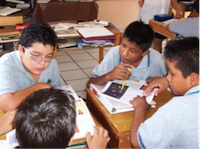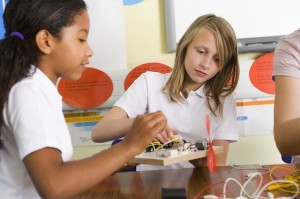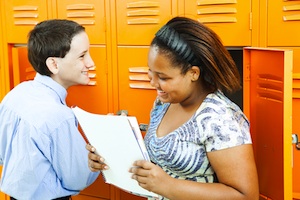New Teachers: Creating a Shiny, Happy Classroom

One of my favorite bands is R.E.M. They wrote this fluffy little song called “Shiny, Happy People” and hearing it always makes me smile. I want my students to have this same experience when they think of my classroom. I want thoughts of life in Room 132 to bring a smile. These are some of the steps I take to try to make that happen.
As teachers begin this school year, their thoughts undoubtedly turn to the classroom climate they want to establish and maintain. One question that I am often asked (especially by newer teachers) is what kind of classroom management program I use. My answer is that I don’t.

I won’t go into the many well-known programs for establishing a positive classroom climate, but all it takes is one quick Google search to retrieve millions of hits. There are dozens of books on the subject already written and more arriving every day.
I feel much of developing a positive classroom climate is common sense about how to treat people. After all, our students are people and should be afforded the same graces many of us save for our significant others, friends, and families.
In my experience, there are three things that need to happen for a shiny, happy classroom to exist.
1) Students must feel safe,
2) Students must feel valued, and
3) Students must feel successful.
Feeling Safe

1. Hold high expectations of all students
This does not mean the same expectations of all students, but rather a high but achievable standard for each child.
Give them the benefit of the doubt and assume that they will do the right thing the majority of the time.
Believe that they can all reach their potential. For that matter, believe that they all HAVE potential.
2. Be firm but fair
Firm does not mean overly strict or outright mean. It means choosing your battles and determining what is most important to you and having a legitimate reason for that policy.
Students remember nit-picky things like failing a paper because they forgot to put their name on top, and it will only damage the relationship in the long run. Is their name in the upper, right-hand corner REALLY the most important thing to you?
3. Model the behavior you wish to see from students
You cannot be overly emotional or dramatic on a regular basis in front of the students. There is nothing scarier to some students than a teacher who randomly flies off the handle and explodes at unexpected times. On the other hand, I have seen students make it a game to be the one to send a “yeller” over the edge. Mood swings of any kind generally make others uncomfortable, and they will begin to block you out.
Don’t tell them they need to pay attention when you are talking and then be a bad listener when they speak.
Don’t tell them they need to be respectful of others and then “tease” some of the students. If you expect them to be kind to one another, then you must also be kind.
Feeling Valued
I wrote about this more extensively in a post at my personal blog (“The Classroom Where Everyone Knows Your Name”), where I said:
I believe that students won’t care how much you know until they know how much you care. Once they realize this—watch out! The potential for learning in your class will be limitless.”

1. Get to know students as individuals.
A positive rapport with your students is the secret weapon when it comes to having a happy classroom. If this does not exist, nothing else you try will ever work.
If you know a little bit about the children beyond the classroom, it will go a long way. Integrate their interests into the classroom.
2. Always help maintain their dignity
Sometimes it is necessary to have a discussion with a child about his/her behavior, but it should not be done in front of other students and should never humiliate a student.
Whenever possible, determine a solution to a problem WITH a student rather than imposing your will on them. Giving them the tools to manage their own behavior is much more effective than you deciding how to control them.
3. Choose your words carefully
You are your words—so choose wisely. Always bear in mind that your words have the power to uplift or crush a child. Use your power for good, not evil.
Feeling Successful

1. Provide engaging instruction
Make sure you know what you are doing before you step in front of the students. Nothing undermines you more than not appearing as if you had a plan.
Incorporate novelty, technology, collaboration, etc. when appropriate to the content. (I find Dave Burgess’s Teach Like a Pirate to have brilliant ideas for getting students’ attention.)
2. Whenever possible, allow for choice and student directed learning
A student-centered classroom is crucial for all students to succeed. One of our central roles as their instructor is to be their coach and their cheerleader as they assume more and more ownership of learning.
3. Clearly communicate your expectations for the assignment
Students can’t hit a target that they can’t see. Don’t make them guess what you were looking for. Let students know what a quality assignment looks like in advance.
4. Provide regular, constructive feedback
There is no place for a “gotcha” grade at the end of an assignment. Students should know their strengths and weaknesses and work on improving BEFORE it “counts.”
5. Nurture and celebrate their successes
Finally, always remember that it’s okay to have fun. “Don’t smile until Christmas” is ridiculous and was bad advice even when it was new!
Cheryl Mizerny is a veteran educator with over 20 years experience–primarily at the middle school level. She began her career in special education, became a teacher consultant and adjunct professor of Educational Psychology, and currently teaches sixth grade English in Bloomfield Hills, Michigan. Her teaching is guided by her belief in reaching every student and teaching the whole child: socially, emotionally, and cognitively. She writes a blog about student motivation and engagement at The Accidental English Teacher.

































Great post, Cheryl! I heartily agree. Have a great start to your year!
Great article… Sharing it with all my staff this year!
Just so easy and simple but so interesting , effective and helpful i am sharing it with my staff this year and hopefuly my school will be the school Where Everybody Remembers Your name CHERYL, Thank you
Julio morales zaldivar
Thank you, everyone. I write from the heart and I am happy if it has been of use to you. I appreciate your positive thoughts.
Yes. You’ve pointed out the essential foci for creating a warm, welcoming, and focused class, Cheryl. Nicely done.
Great article. As an educator and advocate for the arts creating a space of trust is essential. Hopefully modeling this behavior in the classroom can help alleviate bullying outside the classroom and further the mutual respect of students with their peers when left to their devices.
Great post! It can surely help (new) teachers to see the value of a secure and learner-friendly environment where learning occurs and where the learners’ goals become the teacher’s goals.
Eugenia Papaioannou, EFL teacher, teacher trainer, author